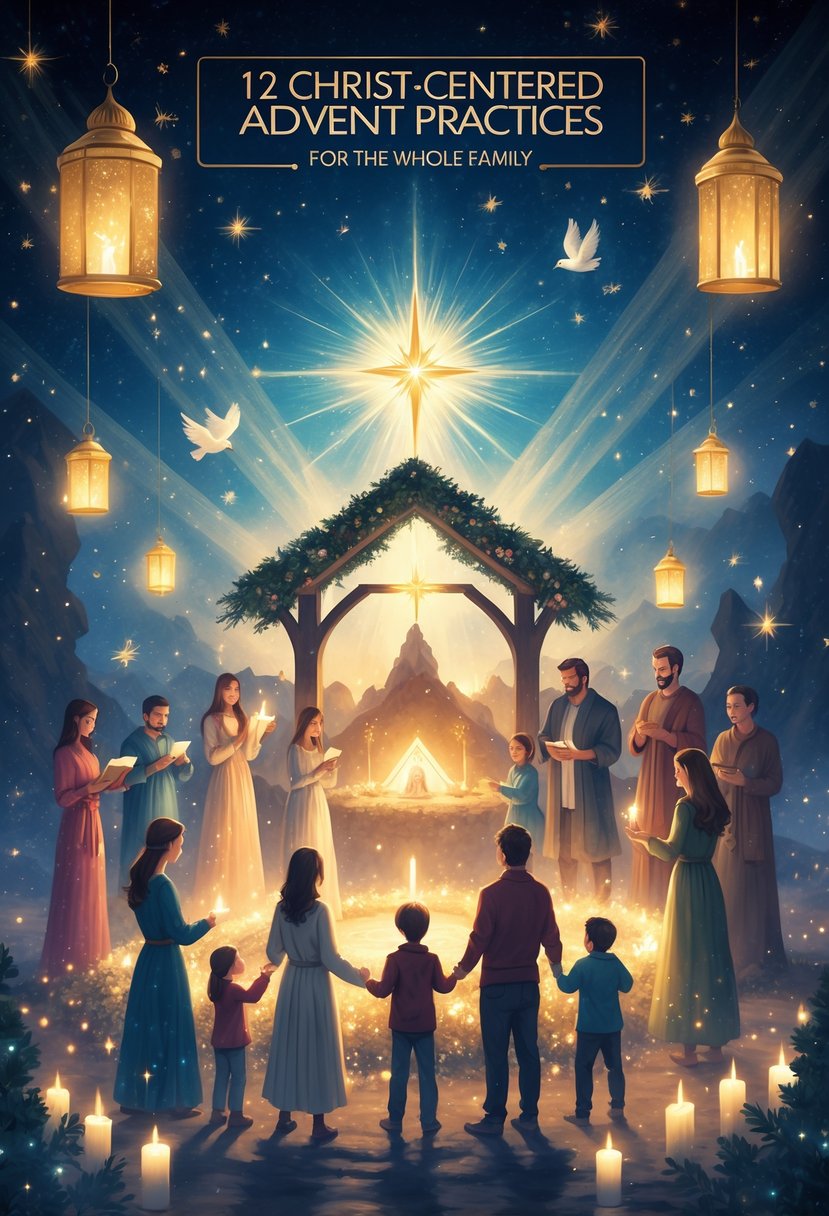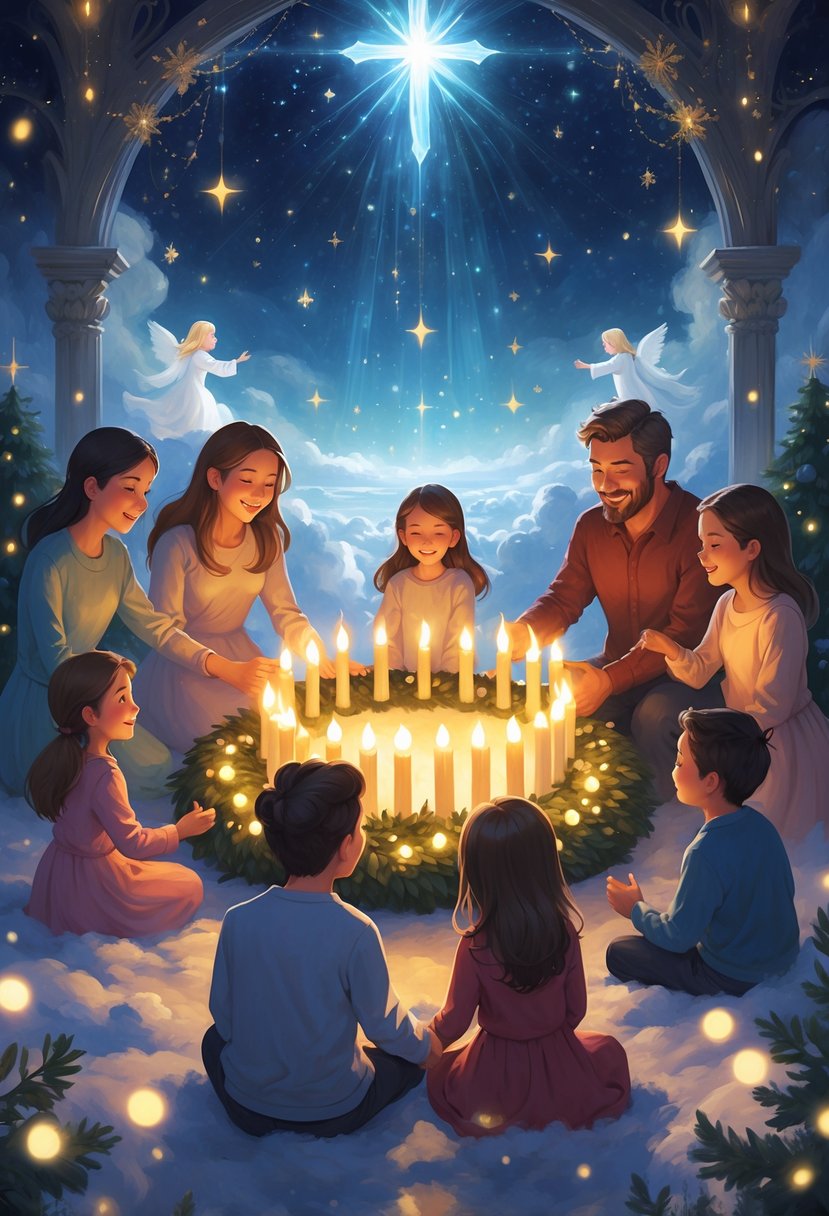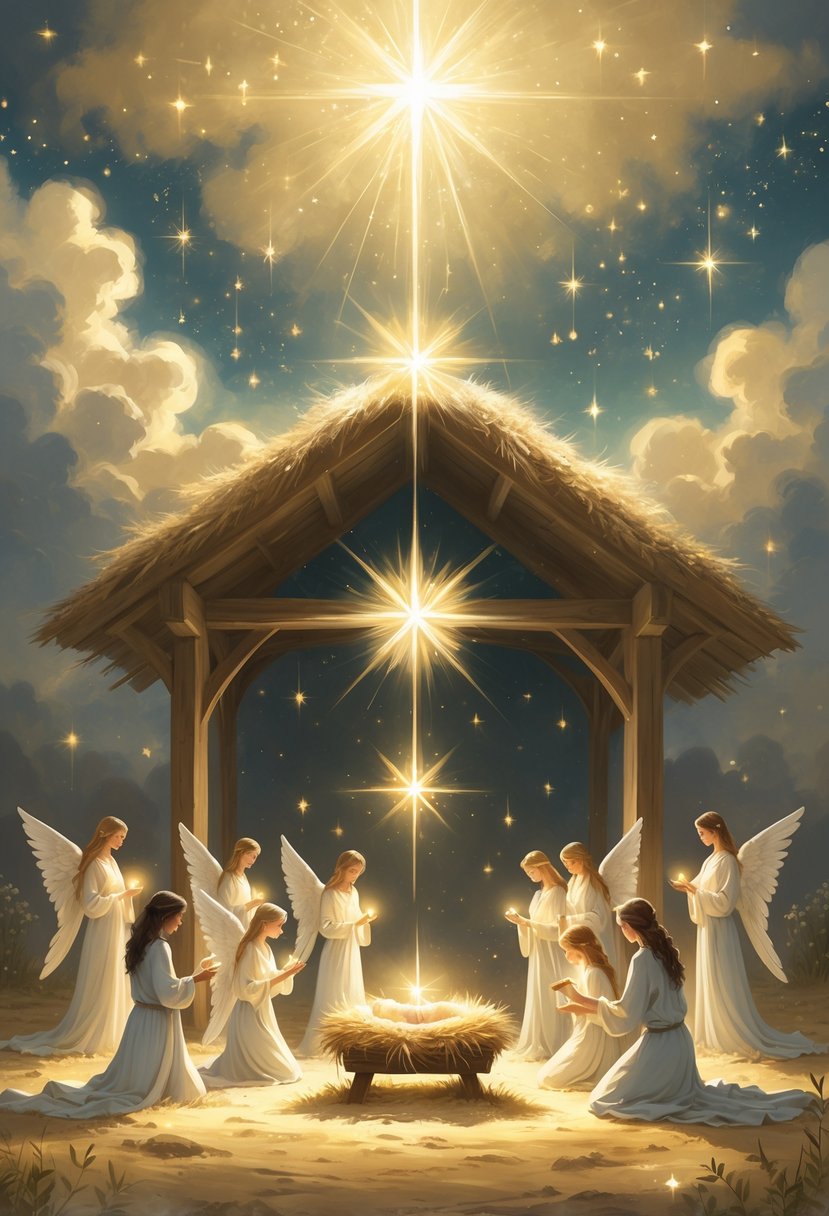The Christmas season can quickly turn into a rush of shopping, parties, and endless to-do lists that drown out the real reason for the celebration. Most families want to prepare their hearts for Jesus’ birth but get swept up in holiday chaos.

When you create Christ-centered Advent traditions, your family slows down and connects with God’s story. These moments build memories that point everyone back to the heart of Christmas.
Maybe you start small—simple prayer times, nothing fancy. Over time, you can add creative traditions like advent calendars or nativity crafts.
These ideas fit families of all sizes and ages. Toddlers, teens, and grandparents can all join in preparing for Christmas with hearts focused on Jesus, not just the pile of presents.
Embracing the Advent Season as a Family

Advent can flip busy December days into meaningful moments of spiritual preparation. The season gives families a chance to reflect on Christ’s birth and build traditions that focus on faith, not just commercial stuff.
The Meaning and Purpose of Advent
Advent covers the four weeks before Christmas when Christians prepare for Jesus’ birth. The word “advent” comes from Latin, meaning “coming” or “arrival.”
This season is about anticipation and spiritual preparation. It’s not just counting down to Christmas morning—it’s making space for reflection on God’s promises.
The traditional Advent themes guide families each week:
- Week 1: Hope – God’s promise of salvation through Christ
- Week 2: Peace – The peace Jesus brings to troubled hearts
- Week 3: Joy – Celebrating God’s faithfulness and love
- Week 4: Love – God’s ultimate gift of His son
These themes remind us that Christmas is more than gift-giving. We’re remembering how God stepped into history through Jesus to offer salvation.
Why Keep Christ at the Center of Christmas
A Christ-centered Christmas shifts your family’s focus from stuff to spiritual truths. When Jesus stays at the center, your celebrations become worship, not just tradition.
Culture says Christmas is about getting and spending. Christ-centered Christmas is about giving and gratitude.
Keeping Christ at the center of Advent helps your family remember the real reason for Christmas. The birth of Jesus is hope for everyone, not just a story from long ago.
Lighting candles turns into prayer time. Reading Scripture becomes a way to connect. These simple acts can create memories rooted in faith.
Creating Intentional Family Traditions
Intentional traditions take a little planning, but they don’t have to be complicated. Pick simple Christ-centered Advent ideas that fit your family’s style.
Try these approaches:
Daily Practices:
- Morning Scripture reading over breakfast
- Evening prayer by candlelight
- Acts of kindness countdown
Weekly Rituals:
- Sunday Advent wreath lighting
- Family service projects
- Christmas story discussions
Consistency matters more than perfection. Pick two or three things your family can actually stick with.
These meaningful Advent activities help kids connect emotionally with the Christmas story. Your traditions should match your family’s personality and point to Christ.
Some families love quiet reflection. Others prefer hands-on service projects. Both can honor Advent if you keep the focus on Jesus.
Daily Christ-Centered Advent Devotions and Prayer

Daily devotions and prayer during Advent give families sacred moments to reflect on Jesus’ coming. Setting aside time, using age-appropriate resources, and consistent prayer routines can turn hectic December days into meaningful preparation.
Incorporating Family Devotion into Advent
Start each Advent day with 10-15 minutes of family devotion. Find a time that works—maybe breakfast or after dinner.
Set up a small Advent space in your home with a Bible, candles, or a simple decoration. This helps everyone look forward to devotion time.
Family Advent devotions work best with Scripture, a short discussion, and prayer. Keep it brief for younger kids but meaningful for everyone.
Let different family members lead. Maybe older kids read the passage, and parents ask questions about Jesus’ birth.
Focus on hope, peace, joy, and love each week. Every Sunday, light a new candle and talk about how that theme connects to Jesus.
Advent Devotional Resources for All Ages
For Young Children (Ages 3-7):
- Picture books with simple Jesus stories
- Ornament crafts that tie into Scripture
- Short prayers with hand motions
For Elementary Ages (8-12):
- 25 daily Bible readings about Jesus’ family tree
- Jesse Tree activities with symbols
- Memory verses from Luke 2
For Teens and Adults:
- Deeper reflections on the Incarnation
- Service projects linked to Advent themes
- Christ-centered devotionals with discussion questions
Printed devotional books that include all ages can be a lifesaver. They often have Scripture, questions, and simple activities.
Busy families sometimes prefer digital options. Audio devotionals work well in the car or while cooking.
Building an Advent Prayer Routine
Pick set prayer times during Advent devotions. Start by asking God to prepare your family’s hearts for Jesus.
Make family prayer lists focused on Advent themes. Pray for hope in tough times, peace in relationships, joy even when life gets hard, and love for others.
Mix in traditional Advent prayers with personal requests. Teach kids simple prayers like “Come, Lord Jesus” or “Maranatha.”
Weekly Prayer Focus:
- Week 1: Prayers of hope and expectation
- Week 2: Prayers for peace in homes and communities
- Week 3: Prayers of joy and gratitude
- Week 4: Prayers expressing love for God and others
Wrap up each devotion with the Lord’s Prayer or a blessing. This helps kids know when devotion time ends.
Try keeping an Advent prayer journal. Let everyone write down requests and thanks. Look back at answered prayers as the season goes on.
Creative and Fun Advent Practices for Families

Interactive traditions bring Bible stories to life with visual storytelling, surprise activities, and meaningful service opportunities. Each one helps your family make lasting memories and understand Christ’s birth more deeply.
The Jesse Tree: Tracing Jesus’ Family Line
The Jesse Tree turns Advent into a visual journey through the Bible. You just need a bare branch in a vase and ornaments for key figures from Adam to Jesus.
Start with simple symbols you can make together. A red apple for Adam and Eve, a rainbow for Noah, stars for Abraham, and a ladder for Jacob.
Read the matching Bible story each night, then hang that day’s ornament. Kids start connecting Old Testament stories to Jesus’ birth, and it just clicks.
Watching the tree fill up over 25 days is special. By Christmas Eve, you’ve made a timeline of salvation history. Many Christ-centered Advent calendar ideas add Jesse Tree elements for daily structure.
Family Advent Bags: Surprises with Meaning
Advent bags mix surprise and spiritual growth. Prepare 25 small bags with Bible verses, simple activities, and little objects that tell the Christmas story.
Tuck in things like star stickers for the wise men or small candles for Jesus as the Light of the World. Add activity cards with devotion instructions, acts of service, or crafts.
Keep it simple but meaningful. A bit of hay can remind everyone of Jesus’ humble birth, and gold chocolate coins stand in for the wise men’s gifts.
Everyone will look forward to opening each day’s bag. Older kids can help prep bags for younger siblings, which makes it a team effort. Creative Advent activities like these often become family favorites.
Acts of Kindness and Service Together
Service flips Advent from receiving to giving. Challenge your family to do one act of kindness every day in December.
Start small. Bake cookies for neighbors, write thank-you notes to helpers, or donate toys your kids don’t use. Visit a nursing home to sing carols or drop off homemade cards.
Make a family service calendar with activities for each day. Little kids can help pack food, while teens might organize a volunteer day.
The goal isn’t to be perfect—just keep serving. Meaningful Advent traditions for families often highlight service as a way to celebrate Christ’s love.
Nativity-Focused Activities to Teach the Christmas Story

Nativity activities make Christ’s birth real through hands-on experiences and storytelling. These practices help families connect with the Christmas story through displays, games, Scripture, and community celebrations.
Setting Up Nativity Scenes in Your Home
Setting up nativity scenes turns your home into a reminder of Christ’s birth. Start with a simple stable scene—Mary, Joseph, and baby Jesus in the living room.
Add more nativity sets in different rooms. Maybe a wooden one on the mantle, a ceramic set on the table, and a kid-friendly version in the playroom.
Try these nativity scene ideas:
- Traditional figurines with stable backdrop
- Handmade clay or paper characters
- Outdoor lighted nativity display
- Soft fabric sets for little ones
Let kids help arrange the figures and tell the story as you go. Move the wise men closer each day to show their journey.
You can make DIY nativity crafts using toilet paper rolls that kids color and put together while learning about each character.
Hide & Seek with Baby Jesus
This tradition helps children remember that Jesus belongs at the center of Christmas. On Christmas Eve, after the kids go to bed, hide the baby Jesus figurine from your nativity scene somewhere in the house.
When morning comes, kids race around searching for baby Jesus before opening presents. The excitement builds, but the focus stays on finding Christ first.
Hide & Seek variations:
- Leave clues leading to baby Jesus.
- Hide multiple baby Jesus figures for bigger families.
- Include Scripture verses at each hiding spot.
- Let children take turns hiding Jesus for their siblings.
Whoever finds baby Jesus gets to place the figurine in the manger. The family might sing a carol or read the nativity story together before diving into gifts.
Reading the Nativity Story from Scripture
Reading Scripture daily during Advent grounds the family in the real nativity story. Focus on Luke 2:1-20 and Matthew 1:18-2:12 as your main passages.
Each evening, read a section leading up to Christmas. For younger kids, break the story into smaller parts so they can follow along.
Scripture reading schedule:
- Week 1: Angel’s announcement to Mary (Luke 1:26-38)
- Week 2: Journey to Bethlehem (Luke 2:1-7)
- Week 3: Shepherds’ visit (Luke 2:8-20)
- Week 4: Wise men’s journey (Matthew 2:1-12)
Encourage kids to act out scenes or use nativity coloring pages that match each passage. Ask questions about the characters and their roles in Jesus’s birth.
On Christmas Eve, gather by candlelight and read the whole nativity story before bedtime.
Attending or Hosting a Live Nativity
Live nativity events make the Christmas story real with dramatic reenactments. Many churches host these scenes in December and invite the whole community.
Attend a local live nativity where people portray Mary, Joseph, shepherds, and wise men. Some even bring in live animals for that authentic touch.
If you’re feeling ambitious, organize a neighborhood live nativity in your yard or at a local park. Assign roles to family and friends from the nativity story.
Live nativity roles to assign:
- Mary and Joseph
- Angels announcing Christ’s birth
- Shepherds watching their flocks
- Wise men following the star
- Innkeeper turning away travelers
Put together simple costumes from bathrobes, towels, and sandals. Set up a stable scene with hay bales and soft lights to create a Bethlehem vibe.
Invite neighbors to join in or just watch while someone reads the nativity story aloud. Finish the evening with Christmas carols celebrating Jesus’s birth.
Advent Calendars and Wreaths: Counting Down to Christmas

Physical reminders like advent calendars help families mark each day leading to Christmas with intentional activities and Scripture. Traditional advent wreaths offer weekly moments for lighting candles and reflecting on hope, peace, joy, and love.
Choosing or Creating a Christ-Centered Advent Calendar
Christ-centered advent calendars keep the focus on Jesus, not just treats. Pick a 12-day countdown or go with the classic 25 days, depending on your December schedule.
Try these meaningful ideas:
Nativity-Based Calendars
- Add a new piece to your nativity scene each day.
- Read Scripture that tells part of Jesus’s birth story.
- Move Mary and Joseph closer to Bethlehem daily.
Names of Jesus Countdown
- Learn a new name for Christ each day, like “Prince of Peace” or “Emmanuel.”
- Make ornaments with each name.
- Talk about what each title means for your family.
Acts of Service Calendar
- Do daily kindness activities as gifts to Jesus.
- Mix in both family and community service.
- Connect each act to how Jesus served others.
DIY advent calendar options range from boxes and envelopes on string to mini bags. Fill each with Scripture, activity cards, or small meaningful items instead of just candy.
Lighting the Advent Wreath Together
The advent wreath has four outer candles plus a center Christ candle. Each Sunday before Christmas, light one more candle and focus on a new theme.
Week 1: Hope Candle (Purple)
Light the first candle and read Isaiah 9:2 about light in darkness. Chat about what you hope for this year and how God keeps His promises.
Week 2: Peace Candle (Purple)
Add the second candle. Read Luke 2:14 about peace on earth and talk about how Jesus brings peace.
Week 3: Joy Candle (Pink)
Now three candles burn. Read Luke 2:10 about great joy. Share what brings your family joy and celebrate God’s gift of salvation.
Week 4: Love Candle (Purple)
All four outer candles glow as you read 1 John 4:9 about God’s love. Reflect on God’s ultimate love in sending Jesus.
Christmas Day: Christ Candle (White)
Light all five candles on Christmas morning. Read John 1:14 about the Word becoming flesh and celebrate Jesus’s birth as a family.
Keep your wreath lighting short but meaningful. Maybe sing a carol, pray together, or share something you’re grateful for each week.
Making and Using Ornaments with Meaning
Make ornaments that tell the Christmas story throughout December. Each one becomes a visual reminder of Jesus’s birth and God’s plan.
Jesse Tree Ornaments
Create symbols for Old Testament stories leading to Jesus:
- Apple for Adam and Eve
- Rainbow for Noah’s covenant
- Star for Abraham’s promise
- Crown for King David
- Angel for the Annunciation
Nativity Scene Ornaments
Craft simple ornaments for the Christmas story:
- Wooden star for Bethlehem’s star
- Small sheep for the shepherds
- Tiny crown for the wise men
- Baby ornament for Jesus
Scripture Verse Ornaments
Write key Christmas verses on plain ornaments with metallic markers. Include references like Luke 2:11, Matthew 1:23, and John 3:16.
Advent calendar crafts can include ornament-making as daily activities. Kids love creating something special while learning Bible stories.
Hang your meaningful ornaments front and center on your tree. Every time someone sees them, they’re reminded of the real reason for Christmas.
Baking, Crafts, and Family-Focused Celebrations

Spending time together in the kitchen and with crafts builds memories and teaches kids about Jesus’s birth. These hands-on activities turn ordinary December nights into something special.
Baking Cookies and Cooking as a Family
Baking cookies together opens up natural conversations about the Christmas story. Shape sugar cookies into stars, angels, and nativity figures and talk about their meaning.
Try a baking night each week during Advent. Switch it up with gingerbread houses, cinnamon stars, or Christmas bread.
Simple Cookie Ideas:
- Star-shaped cookies for the Star of Bethlehem.
- Angel cookies with white icing wings.
- Heart cookies to show God’s love.
Let little ones help with measuring and mixing. Older kids can roll and cut the shapes on their own.
Share your treats with neighbors or church friends. It’s a sweet way to spread joy and Christ’s love.
Family Craft Projects: Creating Together
Christ-centered Christmas crafts make the nativity story hands-on. Simple projects keep everyone engaged and don’t overwhelm busy schedules.
Make a family nativity scene out of clay, felt, or even LEGO bricks. Each person can create a different character during December.
Easy Advent Crafts:
- Paper chain countdown calendars
- Handprint angel ornaments
- Popsicle stick stable scenes
- Salt dough nativity figures
Pick one night a week for family craft time. Choose projects that fit your kids’ ages and attention spans.
Show off finished crafts around your home. These reminders help keep the focus on Jesus all season.
Baking a Birthday Cake for Jesus
Baking a birthday cake for Jesus turns Christmas dessert into a celebration of Christ’s birth. Kids start to understand that Christmas is really about Jesus’s arrival.
Let your kids pick the cake flavor each year. Some families decorate with nativity scenes, others keep it simple with candles.
Bring the cake to family gatherings instead of a regular Christmas dessert. When people ask about it, you get to share what Christmas means to you.
Sing “Happy Birthday” to Jesus before cutting the cake. Some families also share what gifts they want to give Jesus through kindness or service.
Making Christmas Morning and Eve Christ-Centered

Turn Christmas Eve and morning into worshipful, meaningful times with traditions that honor Jesus. These moments invite prayer, reflection, and giving that point your family to the real reason for Christmas.
Meaningful Christmas Eve Box Traditions
A Christmas Eve box can prepare hearts for worship when you fill it with Christ-centered items. Open the box together as the sun goes down on December 24th.
Pack your box with things that help your family focus on Jesus. Add new pajamas, a family devotional, hot chocolate mix, and battery candles for a candlelight service at home.
Slip in a nativity puzzle for the family to work on while listening to Christmas music. Include handwritten Scripture cards with verses from Luke 2 and Matthew 1-2.
Tuck in a Christmas story Bible or a nativity picture book. Kids start to associate the excitement of the box with learning about Jesus, not just presents.
You might also include supplies for a service project, like cookie decorating kits for neighbors or care packages for shelters. This links Christmas Eve to acts of love and kindness.
Stocking for Jesus: Offering Prayers and Gifts
Hang a special stocking for Jesus in a prominent spot with your family stockings. This tradition helps children see Christmas as Jesus’s birthday, not just their own.
Throughout December, invite everyone to write prayers, gratitude notes, or acts of service on colorful strips of paper and place them in Jesus’s stocking.
On Christmas morning, read the offerings together before opening gifts. Kids love hearing their prayers and seeing their service commitments celebrated.
Fill the stocking with symbolic gifts that represent Jesus—maybe a small cross, a lamb figurine, or a star ornament.
Some families add donation receipts for gifts given to charity in Jesus’s name. Others include commitment cards promising acts of kindness in the coming year.
Personal Christmas Cards and Christmas Card Prayers
Turn your Christmas card tradition into a prayer ministry by writing personal messages that share Christ’s love. Instead of generic greetings, include specific prayers for each person.
Let your kids help make Christmas cards with hand-drawn nativity scenes or Scripture. Encourage them to add their own prayers for grandparents, teachers, or friends.
Set aside time during Christmas week for Christmas card prayers, praying over each card before mailing. It turns sending cards into a small act of worship.
Make a family prayer list from your Christmas card addresses. Pray for different families each day leading up to Christmas, asking God to bless them and draw them closer to Jesus.
Consider adding meaningful scripture verses about Christ’s birth in your cards. Share how Jesus has impacted your family this year with real examples, not just general statements.
Sharing the Christmas Message Through Music and Media

Music and visual storytelling have this special way of helping families connect with the birth of Jesus. These activities turn ordinary entertainment into moments of worship and learning that stick with you.
Singing Christmas Carols and Hymns
Christmas carols share Christ’s birth through melody and simple words. Songs like “O Come, All Ye Faithful” and “Silent Night” invite your family to worship together and learn about Jesus in a way that feels natural.
Create a Christ-centered playlist with both classic hymns and newer worship songs that focus on the nativity. Play these in the car, while cooking, or as you decorate your home—honestly, whenever the mood strikes.
Essential Christmas carols to include:
- “Joy to the World” – proclaims Jesus as King
- “O Holy Night” – emphasizes redemption and hope
- “Angels We Have Heard on High” – celebrates the angelic announcement
- “Mary, Did You Know?” – reflects on Mary’s faith journey
Host a Christmas carol sing-along that centers on hymns about Jesus. Invite friends or just keep it cozy with family for a night of singing and worship.
Try teaching your kids the stories behind the carols. There’s a lot of deep meaning in those old hymns about Christ’s birth that can really open up conversations.
A Charlie Brown Christmas: Lessons from Linus
A Charlie Brown Christmas slips in some profound spiritual truths, especially when Linus shares his speech from Luke 2. This classic special pushes back against commercialization and points everyone toward the real meaning of Christmas.
Linus stands on stage and recites the biblical story of Christ’s birth, saying, “That’s what Christmas is all about, Charlie Brown.” His gentle voice makes Scripture feel approachable for kids and reminds us all why it matters.
Key discussion points after watching:
- Why was Linus unashamed to share the gospel?
- How does the Charlie Brown Christmas tree represent transformation?
- What does the special teach about finding joy in simplicity?
Use this film to kick off family conversations about courage and faith. Linus shows what it looks like to share biblical truth, even when everyone else seems distracted by stuff.
The contrast between Charlie Brown’s search for meaning and Linus’s steady faith gives you plenty to talk about—where does real Christmas joy come from, anyway?
Watching the Nativity Story as a Family
Christian Christmas movies that focus on Jesus’s birth create shared family moments rooted in Scripture. Films like “The Nativity Story” bring the Bible to life through visuals and storytelling.
These movies help kids picture the Christmas story and make Christ’s birth feel more real. Watching Mary and Joseph’s journey on screen can spark all kinds of questions and insights.
Recommended nativity films:
- “The Nativity Story” (2006) – comprehensive biblical account
- “The Star” (2017) – animated retelling from animals’ perspective
- “Mary, Mother of Jesus” – focuses on Mary’s faith journey
Watch these films together and pause now and then to talk about God’s faithfulness, fulfilled prophecies, and why Jesus was born in such humble circumstances.
Try reading the matching Scripture passages before or after the movie. It helps tie the story on screen back to God’s Word.
Start a family tradition around these movie nights—maybe with special snacks or a chat about everyone’s favorite scene.
Wrapping Up the Advent Season as a Family

The end of Advent gives your family a chance to pause and think about what stood out most. It’s also a great time to set up habits that keep Christ at the center of your Christmas traditions all year.
Reflecting on Your Advent Journey
On Christmas Eve or Christmas Day, gather everyone and look back on the Advent season. Ask each person to share their favorite moment or something new they learned about Jesus during your Christ-centered Advent activities.
Try a simple reflection activity with questions like:
- What surprised you most about Jesus this Advent?
- Which tradition brought you closest to God?
- How did helping others change your heart?
Maybe start an Advent journal where family members can write or draw about their experiences. Over time, it becomes a special keepsake full of memories and spiritual growth.
Snap photos of your Jesse tree ornaments, the advent wreath, or any nativity scenes you made together. These pictures help you remember the joy and anticipation you felt while waiting in expectation for the coming Christ.
Sustaining Christ-Centered Traditions Year After Year
Build on your Advent traditions by planning for next year before Christmas even ends. Jot down what worked well and what you might want to tweak or add.
Store your Advent materials somewhere safe so they’re easy to find next December. Label boxes clearly and toss in a quick note about which activities your kids actually liked.
Think about ways to keep Christ-centered habits going after Advent.
Monthly Family Devotions – Keep reading Bible stories together, even if it’s just once a month.
Service Projects – Try a family volunteer activity every few months.
Prayer Practices – Stick with the daily family prayer time you started during Advent, if you can.
Make a simple tradition check-in. Keep what brought real joy or spiritual growth. Change up anything that felt rushed or stressful. And honestly, add new things slowly—no need to pile it on all at once.
I’d say the real aim is to build sustainable Christ-centered Christmas traditions that help your family’s faith grow over the years. Start small, and let things build naturally around what draws you closer to Jesus.
Follow us on Social Media!
I’m Nina, and I’m very passionate about spirituality. Exploring the depths of the soul and connecting with the divine has always been my source of inspiration. Join me on a journey of self-discovery and inner peace through my writing.

